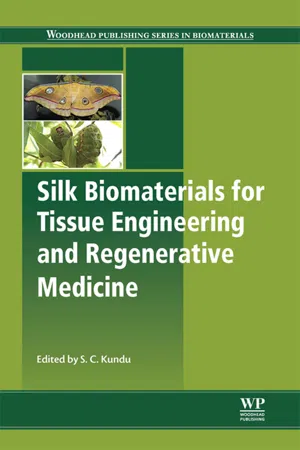
- 582 pages
- English
- ePUB (mobile friendly)
- Available on iOS & Android
Silk Biomaterials for Tissue Engineering and Regenerative Medicine
About This Book
Silk is increasingly being used as a biomaterial for tissue engineering applications, as well as sutures, due to its unique mechanical and chemical properties. Silk Biomaterials for Tissue Engineering and Regenerative Medicine discusses the properties of silk that make it useful for medical purposes and its applications in this area.
Part one introduces silk biomaterials, discussing their fundamentals and how they are processed, and considering different types of silk biomaterials. Part two focuses on the properties and behavior of silk biomaterials and the implications of this for their applications in biomedicine. These chapters focus on topics including biodegradation, bio-response to silk sericin, and capillary growth behavior in porous silk films. Finally, part three discusses the applications of silk biomaterials for tissue engineering, regenerative medicine, and biomedicine, with chapters on the use of silk biomaterials for vertebral, dental, dermal, and cardiac tissue engineering.
Silk Biomaterials for Tissue Engineering and Regenerative Medicine is an important resource for materials and tissue engineering scientists, R&D departments in industry and academia, and academics with an interest in the fields of biomaterials and tissue engineering.
- Discusses the properties and applications of silk for medical purposes
- Considers pharmaceutical and cosmeceutical applications
Frequently asked questions
Information
Introduction to silk biomaterials
Abstract:
1.1 Introduction
1.2 General information about silkworms
| Silks | Main silk species | Biological name | Main food plants | Distribution, shown mainly in Indian states | Voltinism (number of crops in a year) | Cocoon color(s) |
| Mulberry | Bombyx mori | Morus alba, M. australis, M. nigra, M. atropurpurea, M. cathayana, M. liboensis, M. macroura, M. notabilis, M. serrata, M. tillaefolia and other Morus spp. | Mainly in Karnataka, Andhra Pradesh, West Bengal, Tamil Nadu and Jammu and Kashmir | Uni- (1 crop), bi- (2 crops) and multivoltines (4–5 crops) | Mostly dark, pale yellow and white | |
| Nonmulberry | Tropical tasar Oak tasar (temperate tasar) Chinese Oak tasar | Antheraea mylitta (largest cocoon) A. proylei A. roylei A. frithi A. pernyi | Terminalia arjuna, T. tomentosa, Shorea robusta, Quercus incana, Q. serrata, Q. semicarpifolia, Q. himalayana and other Quercus spp. | Tropical parts of India mainly Andhra Pradesh, Bihar, Jharkhand, Madhya Pradesh, Orissa, Uttar Pradesh, West Bengal. Manipur, Nagaland, Assam, Sub-Himalayan belt, Jammu and Kashmir, Himachal Pradesh China | Bivoltine, trivoltine (3 crops) | Yellow/grey/ dark brown; golden light brown; double layers white; pale spotted dark brown; light brown; all single layer |
| Fagaria tasar | Attacus atlas (largest moth) | Maesa indica Evodia fraxinifolia | Assam, Nagaland, Mizoram | Bivoltine | Uneven shaped, spotted dark brown | |
| Muga | Antheraea assamensis (assama) | Litsea polyantha, L. citrate, L salicifolia, Persea bombycina | Assam (more than 95%), Meghalaya, Nagaland, Manipur, West Bengal | Multivoltine | Single layer, vibrant light brown; golden | |
| Eri (semidomesticated) | Samia (Philosamia) ricini | Ricinus communis Heteropanax fragrans Evodia fraxinifolia Manihot esculenta | North-east ... |
Table of contents
- Cover image
- Title page
- Table of Contents
- Copyright
- Contributor contact details
- Woodhead Publishing Series in Biomaterials
- Foreword
- Part I: Fundamentals, processing and types of silk biomaterials
- Part II: Properties and behaviour of silk biomaterials
- Part III: Tissue engineering, regenerative medicine and biomedical applications of silk biomaterials
- Index